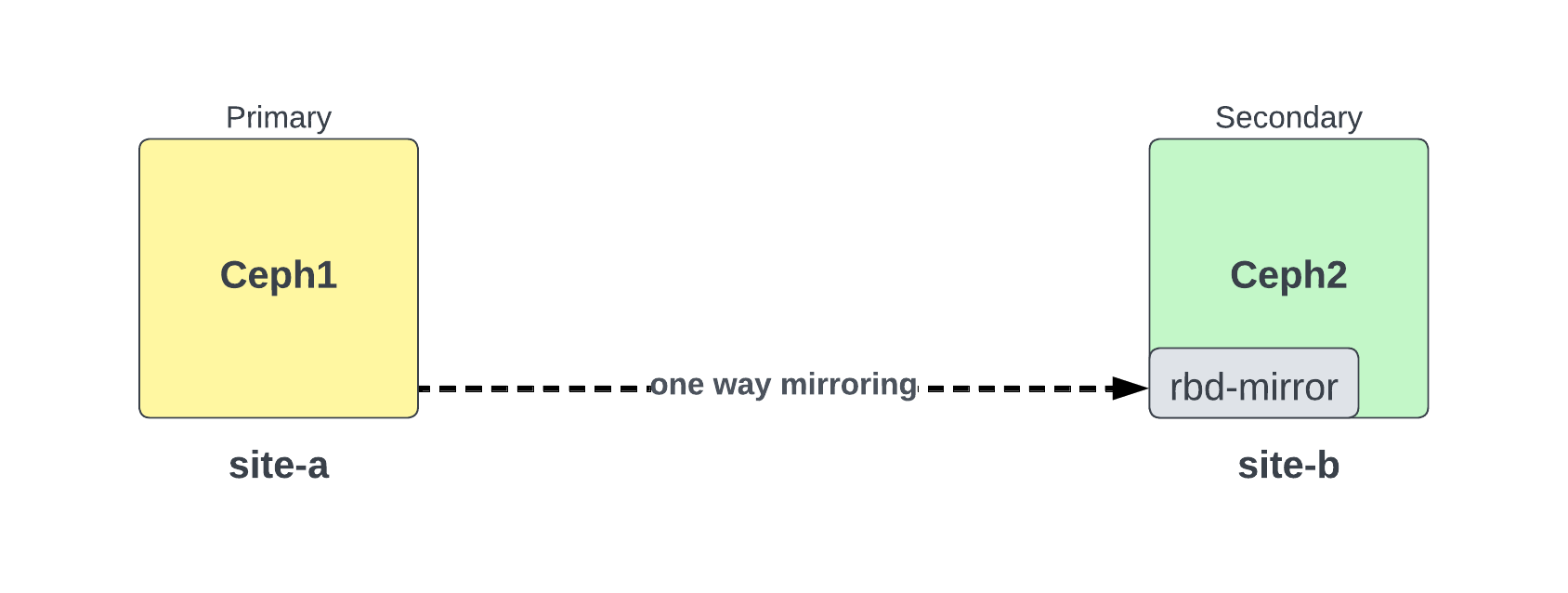
Ceph RBD Mirroring
- 5 minsCeph mirroring is asynchronously mirrored between two Ceph storage cluster. It provide data replication between two sites for disaster recovery. By locating a Ceph storage cluster in different geographic locations, RBD Mirroring can help you recover from a site disaster.
Scope
Setting up a one-way mirror between distinct Ceph clusters: one cluster acts as the source, and the other is the backup.
- Create Ceph cluster (site-a and site-b)
- Deploy rbd-mirror on site-b
- Enable Journaling feature
- Enable mirroring mode on both sites
- Create access token for peers
- Test replication/mirroring

Create ceph cluster
I’ve two servers and I’m creating two ceph clusters ceph1 and ceph2 using loop device as a OSDs. If you have physical disk you can use them.
Following process apply on both servers ceph1 and ceph2 (change –mon-ip according servers ip)
$ curl --silent --remote-name --location https://github.com/ceph/ceph/raw/quincy/src/cephadm/cephadm
$ chmod 700 cephadm
$ ./cephadm add-repo --release quincy
$ ./cephadm install
$ cephadm bootstrap --mon-ip 10.30.50.21 --allow-fqdn-hostname
Create fake OSD using loop device
$ fallocate -l 100G 100G-DISK-0.img
$ fallocate -l 100G 100G-DISK-1.img
$ fallocate -l 100G 100G-DISK-3.img
$ losetup -fP 100G-DISK-0.img
$ losetup -fP 100G-DISK-1.img
$ losetup -fP 100G-DISK-3.img
# find out loopX number in lsblk or fdisk command output.
$ pvcreate /dev/loop0
$ pvcreate /dev/loop1
$ pvcreate /dev/loop2
$ vgcreate CEPH-VG /dev/loop0 /dev/loop1 /dev/loop2
$ lvcreate --size 99G --name CEPH-LV-0 CEPH-VG
$ lvcreate --size 99G --name CEPH-LV-1 CEPH-VG
$ lvcreate --size 99G --name CEPH-LV-2 CEPH-VG
Add lvm disk to ceph
$ ceph orch daemon add osd ceph1:/dev/CEPH-VG/CEPH-LV-0
$ ceph orch daemon add osd ceph1:/dev/CEPH-VG/CEPH-LV-1
$ ceph orch daemon add osd ceph1:/dev/CEPH-VG/CEPH-LV-2
Verify OSDs
$ ceph osd tree
ID CLASS WEIGHT TYPE NAME STATUS REWEIGHT PRI-AFF
-1 0.29005 root default
-3 0.29005 host ceph1
0 ssd 0.09668 osd.0 up 1.00000 1.00000
1 ssd 0.09668 osd.1 up 1.00000 1.00000
2 ssd 0.09669 osd.2 up 1.00000 1.00000
By default, the crush map tells Ceph to replicate the PGs into different hosts. Let’s change crushmap to use replication to osd instead hosts.
$ ceph osd getcrushmap -o crushmap.cm
$ crushtool --decompile crushmap.cm -o crushmap.txt
Edit crushmap.txt file to change replicated_rule to osd.
# rules
rule replicated_rule {
id 0
type replicated
min_size 1
max_size 10
step take default
step chooseleaf firstn 0 type osd # <---- REPLACE HERE FROM host TO osd
step emit
}
Recompile the crush map:
$ crushtool --compile crushmap.txt -o new_crushmap.cm
$ ceph osd setcrushmap -i new_crushmap.cm
Check ceph status. It should be HEALTH_OK
$ ceph -s
cluster:
id: 8f982712-b4e0-11ee-9dc5-c1ca68d609fa
health: HEALTH_OK
services:
mon: 1 daemons, quorum ceph1 (age 19h)
mgr: ceph1.bwbexu(active, since 19h)
osd: 3 osds: 3 up (since 18h), 3 in (since 18h)
rbd-mirror: 1 daemon active (1 hosts)
data:
pools: 5 pools, 129 pgs
objects: 39 objects, 451 KiB
usage: 892 MiB used, 296 GiB / 297 GiB avail
pgs: 129 active+clean
io:
client: 2.0 KiB/s rd, 2 op/s rd, 0 op/s wr
Create “vms” pool on both sites. (We will use this pool for rbd-mirroring)
$ ceph osd pool create vms
$ rbd pool init vms
Deploy rbd-mirror daemon (site-b)
Deploy rbd-mirror daemon using cephadm on site-b only
[site-b]$ ceph orch apply rbd-mirror --placement=ceph2
Verify rbd-mirror daemon
[site-b]$ ceph orch ps | grep rbd-mirror
rbd-mirror.ceph2.ghmncx ceph2 running (17h) 9m ago 17h 74.2M - 17.2.7 4c9b44e95067 d509b0a4d145
Enable journaling on site-a
To enable journaling on all new images by default, set the configuration parameter using ceph config set command.
[site-a]$ ceph config set global rbd_default_features 125
[site-a]$ ceph config show mon.ceph1 rbd_default_features
125
Enable mirroring mode on both sites
Choose the mirroring mode, either pool or image mode, on both the storage clusters. (In our example we will set pool mode on “vms” pool)
[site-a]$ rbd mirror pool enable vms pool
[site-b]$ rbd mirror pool enable vms pool
Check mirror status on both sites. (If you notice Peer status is: none, Because we didn’t form authentication yet)
[site-a]$ rbd mirror pool info vms
Mode: pool
Site Name: 94b146f9-9ef3-4a89-bff1-9746a75d0629
Peer Sites: none
Create Access token for peers
Create Ceph user accounts, and register the storage cluster peer to the pool, This example bootstrap command creates the client.rbd-mirror.site-a and the client.rbd-mirror-peer Ceph users.
[site-a]$ rbd mirror pool peer bootstrap create --site-name site-a vms > /root/bootstrap_token_site-a
Copy the bootstrap token file (bootstrap_token_site-a) to the site-b storage cluster and import token.
[site-b]$ rbd mirror pool peer bootstrap import --site-name site-b --direction rx-only vms /root/bootstrap_token_site-a
Verify rbd mirror pool status on both sites.
[site-a]$ rbd mirror pool info vms
Mode: pool
Site Name: site-a
Peer Sites:
UUID: 25925ad3-bb27-4d08-8a70-abd79b3ffb49
Name: site-b
Mirror UUID: 94b146f9-9ef3-4a89-bff1-9746a75d0629
Direction: tx-only
[site-b]$ rbd mirror pool info vms
Mode: pool
Site Name: site-b
Peer Sites:
UUID: f51a62f1-c176-4ca6-b38f-56afbc822f0a
Name: site-a
Direction: rx-only
Client: client.rbd-mirror-peer
Test RBD Mirroring
Create test file on ceph1 (site-a)
[site-a]$ rbd create myfile1 --size 1024 --pool vms
Verify on ceph2 (site-b). Voilla!!!
[site-b]$ rbd -p vms ls
myfile1
Check health status of mirror replaying on both sites.
$ rbd mirror pool status vms
health: OK
daemon health: OK
image health: OK
images: 1 total
1 replaying
NOTES: Journaling doesn’t apply to old and existing files. You can enable journal manually on old files.
[site-a]$ rbd feature enable vms/myoldfiles1 journaling
Enjoy!!